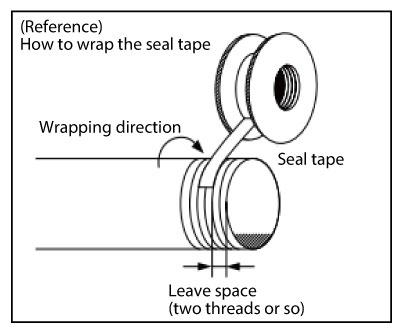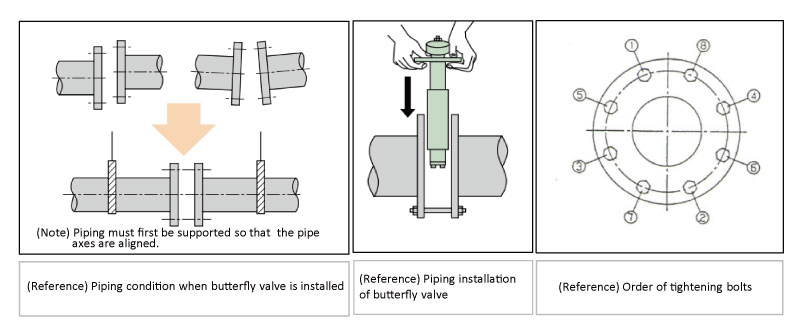External Leakage Questions
- Gate Valves
- Globe Valves
- Ball Valves
- Fluid leaks from the gland.
-
Check the packing retaining nut, gland bolts and nuts for looseness.
It is possible to prevent leakage by retightening them before use.● For valves with packing retaining nut design
Be sure to depressurize the inside of the valve and confirm that the pressure has dropped to the atmospheric level.
Retighten the nut with a spanner or wrench to the extent that the handle operation torque does not become to high.● For valves with gland nuts / bolts design
Be sure to depressurize the inside of the valve and confirm that the pressure has dropped to the atmospheric level.
Evenly tighten the gland nuts with a spanner or wrench so that the gland flange is installed parallel to the pipe.The gland area is sealed by the packing with pressure applied to its surface.
If the packing is kept under the surface pressure for a certain period of time, its shape is deformed with time.
As a result, stress relaxation takes place on the packing, and the nuts need to be retightened.
Applicable product
- Gate Valves
- Globe Valves
- Check Valves
- Ball Valves
- Fluid leaks from the screwed area.
-
When connecting the valve to the pipe, wrap PTFE seal around the male threads or apply a thin layer of suitable liquid sealant. Do not use a tool and screw the pipe manually to insert it to the deepest position of the valve bore, while carefully checking the feel for the right fit of the threads.
Choose and used an appropriate seal tape suitable to the fluid used, working temperature and other parameters. Make sure that the seal material does not enter inside the valve.
When wrapping the tape, it should be wrapped two or three times in the same direction as the thread-tightening direction.
If the tape is wrapped in the opposite direction, the pipe may be loosened during installation, leading to leakage.
Applicable product
- Gate Valves
- Globe Valves
- Check Valves
- Ball Valves
- The valve body was cracked, causing external leakage.
-
When the residual water in the pipe or valve is frozen, the product may be damaged and external leakage may occur.
In an environment where freezing is expected, remove the residual water from the pipe or implement the appropriate anti-freezing measures, such as thermal insulation or heater, to the valve and pipeline.
Applicable product
- Butterfly Valves
- Leakage occurs from the connection area between the butterfly valve and flanges.
-
① When the valve is pushed in a narrow space between the pipe flanges, the rubber seat may be deformed, leading to leakage.
When installing the valve to the pipe, use jack bolts as needed to adjust the space between the pipe flanges.At this time, allow 6 to 10 mm extra space between the pipe flanges compared to the space between the valve surfaces and then insert the valve.Do not tighten the bolts at this time. Gradually tighten the bolts evenly and alternately in a star pattern to avoid uneven tightening. Tighten the bolts until both flanges come into contact with the valve body.
* If the bolts are further tightened even after the flanges come into contact with the valve body, the valve body may be damaged.
* Do not use an impact wrench to tighten the bolts.
Refer to our operation manual for more details on valve installation.② The pipe on the upstream and the one on the downstream may not be properly aligned. When installing the valve, be sure to align the center of the valve with that of the pipes. In doing so, be careful that excessive piping stress is not applied to the valve.
③ If the bolts are tightened unevenly, external leakage may occur.
Do not tighten the bolts at a time to avoid uneven tightening. Tighten the bolts evenly and alternately in a star pattern.
Applicable product
- T-Plus
- There is a leak from the area of connection between the main pipe and T-Plus.
-
① The tightening torque for the pipe mounting bolts of the T-Plus may be insufficient, or the bolts may be tightened unevenly.
When the bolt tightening torque is insufficient or the bolts are tightened unevenly, the T-Plus and the pipe may be misaligned due to the impact caused by the piston movement, resulting in damage of the gasket because it is pulled by the pipe. This may cause external leakage in some cases.② The fluid may remain in the branch pipe.
Water used during the pressure test may remain in the pipe after the installation of the branch pipe. When the piston moves with that state, such movement may compress the water in the branch pipe, resulting in abnormal rise in pressure inside the branch pipe.
Because of the balance between this raised pressure in the branch pipe and the piston driving pressure causes insufficient lowering of the piston. The abnormally raised pressure from the branch pipe may damage the gasket, which is made of a piping material with a weaker strength, resulting in a condition prone to external leakage in some cases.③ The pipe may be deformed.
If the bolts for mounting the T-Plus to the pipe are tightened excessively, this may deform the pipe, the sealing performance of the gasket cannot be achieved, leading to external leakage. When tightening the bolts, refer to the tightening torque value shown below before performing the work.
Applicable product
